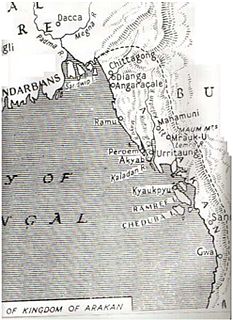 W
WThe 1762 Arakan earthquake occurred at about 17:00 local time on 2 April, with an epicentre somewhere on the coast from Chittagong to Arakan in modern Burma. It had an estimated magnitude of as high as 8.8 on the moment magnitude scale and a maximum estimated intensity of XI (Extreme) on the Mercalli intensity scale. It triggered a local tsunami in the Bay of Bengal and caused at least 200 deaths. The earthquake was associated with major areas of both uplift and subsidence. It is also associated with a change in course of the Brahmaputra River to from east of Dhaka to 150 kilometres (93 mi) to the west via the Jamuna River.
 W
WThe Burmese–Siamese War (1759–1760) was the first military conflict between the Konbaung Dynasty of Burma (Myanmar) and the Ban Phlu Luang Dynasty of Siam (Thailand). It reignited the centuries-long warfare between the two states that would go on for another century. The Burmese were "on the brink of victory" when they suddenly withdrew from their siege of Ayutthaya because their king Alaungpaya had fallen ill. He died three weeks later, ending the war.
 W
WThe Burmese–Siamese War (1765–1767) was the second military conflict between the Konbaung dynasty of Burma (Myanmar) and the Ban Phlu Luang Dynasty of Siam (Thailand), and the war that ended the four-century-old Ayutthaya kingdom of Siam. Nonetheless, the Burmese were soon forced to give up their hard-won gains when the Chinese invasions of their homeland forced a complete withdrawal by the end of 1767. A new Siamese dynasty, to which the current Thai monarchy traces its origins, emerged to reunify Siam by 1770.
 W
WThe Karenni States, also known as Red Karen States, was the name formerly given to the states inhabited mainly by the Red Karen, in the area of present-day Kayah State, eastern Burma. They were located south of the Federated Shan States and east of British Burma.
 W
WArakan is a historic coastal region in Southeast Asia. Its borders faced the Bay of Bengal to its west, the Indian subcontinent to its north and Burma proper to its east. The Arakan Mountains isolated the region and made it accessible only by the Indian subcontinent and the sea. The region now forms the Rakhine State in Myanmar.
 W
WKingdom of Vientiane was formed in 1707 as a result of the split of the Kingdom of Lan Xang. The kingdom was a Burmese vassal from 1765 to 1778. It then became a Siamese vassal until 1828 when it was annexed by Siam.
 W
WThe Konbaung dynasty, formerly known as the Alompra dynasty, or Alaungpaya dynasty, was the last dynasty that ruled Burma/Myanmar from 1752 to 1885. It created the second-largest empire in Burmese history and continued the administrative reforms begun by the Toungoo dynasty, laying the foundations of the modern state of Burma. The reforms, however, proved insufficient to stem the advance of the British, who defeated the Burmese in all three Anglo-Burmese wars over a six-decade span (1824–1885) and ended the millennium-old Burmese monarchy in 1885.
 W
WThe Konbaung–Hanthawaddy War was the war fought between the Konbaung Dynasty and the Restored Hanthawaddy Kingdom of Burma (Myanmar) from 1752 to 1757. The war was the last of several wars between the Burmese-speaking north and the Mon-speaking south that ended the Mon people's centuries-long dominance of the south.
 W
WThe Kingdom of Mrauk-U was an independent coastal kingdom of Arakan which existed for over 350 years. It was based in the city of Mrauk-U, near the eastern coast of the Bay of Bengal. The kingdom from 1429 to 1785 ruled over what is now Rakhine State, Myanmar and Chittagong Division, Bangladesh. From 1429 to 1531 it was a protectorate of the Bengal Sultanate at different time periods. After gaining independence from Bengal, it prospered with help from the Portuguese settlement in Chittagong. In 1666, it lost control of Chittagong after a war with the Mughal Empire. Its reign continued until the 18th century, when it fell to the invasion of the Burmese Empire.
 W
WThe Sino-Burmese War, also known as the Qing invasions of Burma or the Myanmar campaign of the Qing dynasty, was a war fought between the Qing dynasty of China and the Konbaung dynasty of Burma (Myanmar). China under the Qianlong Emperor launched four invasions of Burma between 1765 and 1769, which were considered as one of his Ten Great Campaigns. Nonetheless, the war, which claimed the lives of over 70,000 Chinese soldiers and four commanders, is sometimes described as "the most disastrous frontier war that the Qing dynasty had ever waged", and one that "assured Burmese independence". Burma's successful defense laid the foundation for the present-day boundary between the two countries.
 W
WThe Kingdom of Thonburi was a Siamese kingdom after the downfall of the Ayutthaya Kingdom by the Konbaung Burmese invaders. The kingdom was founded by King Taksin the Great, who relocated the capital to Thonburi. The kingdom of Thonburi existed from 1767 to 1782. In 1782, King Rama I founded the Rattanakosin Kingdom and relocated the capital to Bangkok on the other side of the Chao Phraya River, thus bringing the Thonburi kingdom to an end. The city of Thonburi remained an independent town and province until it was merged into Bangkok in 1971.
 W
WThe Toungoo dynasty, and also known as the Restored Toungoo dynasty, was the ruling dynasty of Burma (Myanmar) from the mid-16th century to 1752. Its early kings Tabinshwehti and Bayinnaung succeeded in reunifying the territories of the Pagan Kingdom for the first time since 1287 and in incorporating the Shan States for the first time. At its peak, the First Toungoo Empire also included Manipur, Chinese Shan States, Siam and Lan Xang. But the largest empire in the history of Southeast Asia collapsed in the 18 years following Bayinnaung's death in 1581.